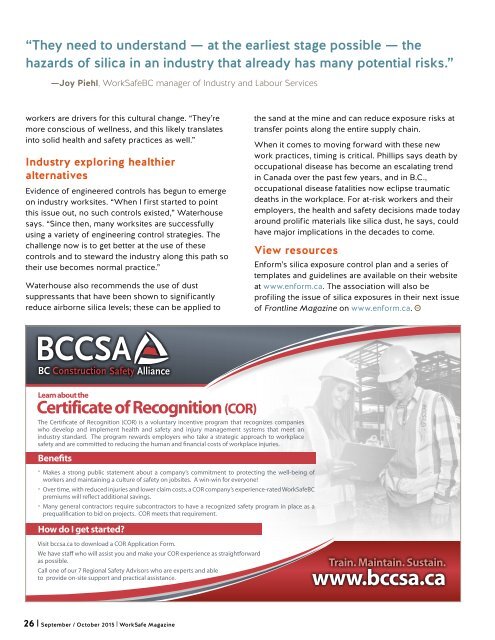WorkSafe
ZUJe3
ZUJe3
You also want an ePaper? Increase the reach of your titles
YUMPU automatically turns print PDFs into web optimized ePapers that Google loves.
“They need to understand — at the earliest stage possible — the<br />
hazards of silica in an industry that already has many potential risks.”<br />
—Joy Piehl, <strong>WorkSafe</strong>BC manager of Industry and Labour Services<br />
workers are drivers for this cultural change. “They’re<br />
more conscious of wellness, and this likely translates<br />
into solid health and safety practices as well.”<br />
Industry exploring healthier<br />
alternatives<br />
Evidence of engineered controls has begun to emerge<br />
on industry worksites. “When I first started to point<br />
this issue out, no such controls existed,” Waterhouse<br />
says. “Since then, many worksites are successfully<br />
using a variety of engineering control strategies. The<br />
challenge now is to get better at the use of these<br />
controls and to steward the industry along this path so<br />
their use becomes normal practice.”<br />
Waterhouse also recommends the use of dust<br />
suppressants that have been shown to significantly<br />
reduce airborne silica levels; these can be applied to<br />
the sand at the mine and can reduce exposure risks at<br />
transfer points along the entire supply chain.<br />
When it comes to moving forward with these new<br />
work practices, timing is critical. Phillips says death by<br />
occupational disease has become an escalating trend<br />
in Canada over the past few years, and in B.C.,<br />
occupational disease fatalities now eclipse traumatic<br />
deaths in the workplace. For at-risk workers and their<br />
employers, the health and safety decisions made today<br />
around prolific materials like silica dust, he says, could<br />
have major implications in the decades to come.<br />
View resources<br />
Enform’s silica exposure control plan and a series of<br />
templates and guidelines are available on their website<br />
at www.enform.ca. The association will also be<br />
profiling the issue of silica exposures in their next issue<br />
of Frontline Magazine on www.enform.ca. W<br />
26<br />
September / October 2015 | <strong>WorkSafe</strong> Magazine


